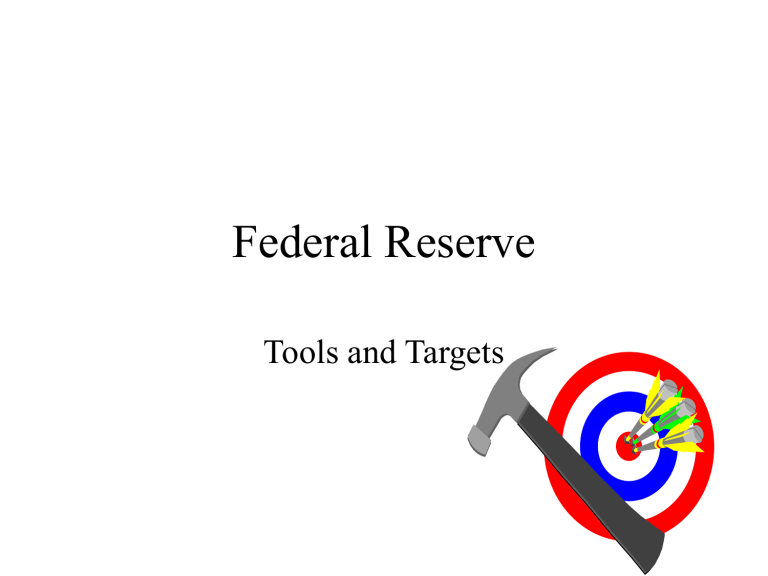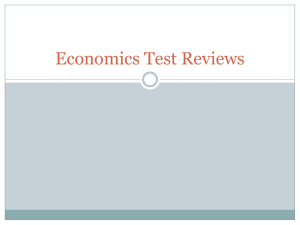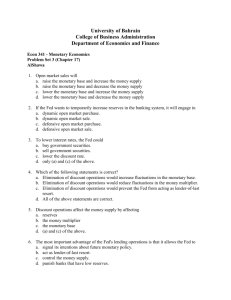Federal Reserve

Federal Reserve
Tools and Targets
Open Market Operations
• Types:
– Dynamic
• Designed to change base
– Defensive
• Meant to offset other factors affecting base
• Purpose:
– Change the monetary base.
Open Market Operations
• Advantages:
– Controlled by the Fed
– Flexible and precise
– Easily reversed
– Implemented quickly
Discount Loans
• Purpose:
– Influence reserves in the banking system
– Lender of Last Resort
• Prevent bank panics
• Prevent non-bank financial panics
Types of Discount Loans
• Primary Credit
– Restricts eligibility to generally sound institutions.
• The goal is to eliminate institutions’ incentive to borrow to exploit the positive spread of money market rates over the discount rate.
• The Fed expects that the restriction of eligibility will reduce its need to review borrowers’ funding situations; thereby, encouraging banks to use the discount window during tight markets.
Types of Discount Loans
• Primary Credit
– Primary credit is extended at a rate that is above the usual level of short term market interest rates, including the federal funds rate.
Types of Discount Loans
• Secondary Credit
– Secondary credit is available in appropriate circumstances to depositary institutions that do not qualify for primary credit.
– Secondary credit is extended at an interest rate that is 50 basis point above the primary discount rate.
Changes to the Discount Window
Feature
Rate
Previous System
Fed funds rate less
25-50 basis points
Term
Eligibility
Overnight
Subjective
Administration Evaluated for appropriateness
Use of funds Can’t resell
Primary Credit
Fed funds rate plus
100 basis points
Overnight
Sound banks only
Minimal,
Market based
No restrictions
Discount Loans
• Advantages:
– Lender of Last Resort function.
• Disadvantages:
– Confusion interpreting discount rate changes.
– Fluctuations in discount loans can cause unintended fluctuations in the money supply.
– Not fully controlled by the Fed.
Reserve Requirements
• Types:
– Required reserves
– Excess reserves
• Purpose:
– Originally, reserve requirements were meant to provide a cushion of reserves to meet unexpected depositor demands for funds.
Reserve Requirements
• Advantages:
– Changes in reserve requirements can change the rate of growth in the money supply rapidly.
• Disadvantages:
– Increases can cause serious liquidity problems for banks.
– Continually fluctuating reserve requirements create uncertainty for banks and make liquidity management more difficult.
Targets
Monetary Policy Goals
• The goals of monetary policy are:
– High employment
– Economic growth
– Price stability
– Interest rate stability
– Financial markets stability
– Exchange rate stability
Monetary Policy Targets
• The central bank wants to achieve its goals, but it does not directly influence the goals.
• It has a set of tools that affect the goals indirectly after a period of time.
• Therefore, the Fed must aim at targets that lie between its tools and its goals.
Targets
• Intermediate Targets:
– Monetary aggregates such as M1and M2
– Interest rates
• Operating Targets:
– Reserve aggregates such as reserves, nonborrowed reserves, monetary base, nonborrowed base.
– Interest rates such as the federal funds rate or the Treasury bill rate.
Choosing the Target
• There are two types of targets:
– Aggregates (Monetary and Reserve)
– Interest rates.
• When the Fed chooses one target, it loses control over the other.
i h i i l
0
MD low
Money Demand
At high rates of interest, people hold interest bearing assets so money demand is low.
At low rates of interest, people hold fewer interest bearing assets so money demand is higher.
MD high
Money
Demand
Money
i
Money
Supply
Money Supply
The money supply is determined by the
Federal Reserve.
At every rate of interest, the money supply is the same.
0
MS Money
i i
3 i
2 i
1
0
Targeting the Money Supply
Money
Supply
Let money demand fluctuate between
MD
1 and MD
3
, causing interest rates to fluctuate between i
1 and i
3
.
MD
3
Targeting the money supply leads to loss of control over interest rates.
MD
2
MD
1
Money
Targeting Interest Rates
i* i
MS
1
MS
2
MSs
3 Let money demand fluctuate between
MD
1 and MD
3
, causing interest rates to fluctuate between i
1 and i
3
.
MD
3
MD
2
MD
1
To set interest at i*, money supply must fluctuate between MS
1 and MS
3
.
Targeting interest rates leads to loss of control over the money supply.
0
Money
Monetary Policy Targets
• It is not possible for the Federal Reserve to change economic conditions directly.
• Strategy:
– Decide on goals for the overall economy.
– Choose a set of variables called intermediate targets that it believes will have an impact on the overall economy.
– Choose another set of variables called operating targets that impact the intermediate targets.
Target Criteria
• Measurability
–
Intermediate Targets
• Data on monetary aggregates are available after a two week delay.
• Data on interest rates are available daily.
– But real interest rates (interest rates adjusted for expected inflation) are hard to measure because there is no direct way to measure expected inflation.
–
Operating Targets
• Data on reserve aggregates and the federal funds rate are available daily.
Target Criteria
• Controllability
–
Intermediate Targets
• The Fed’s control of the money supply is good but not perfect.
• The Fed can change interest rates through open market operations.
–
Operating Targets
• The Fed easily controls base and the federal funds rate.
Target Criteria
• Predictable Effect on Goals
–
Intermediate Targets
• The ultimate economic goal is the target of the intermediate target.
– If the goal is price stability, a change in the money supply or interest rates should change the price level.
– If the goal is economic growth, a change in the money supply of interest rates should change the rate of growth in
GDP.
Target Criteria
• Predictable Effect on Goals
–
Operating Targets
• The intermediate target is the goal of the operating target.
– If the intermediate target is interest rates, the operating target will also be an interest rate variable such as the federal funds rate.
– If the intermediate target is a monetary aggregate, the operating target will also be a reserve aggregate variable such as base.
Lags
• Data lag
– Time to obtain information
• Recognition lag
– Time to understand the information
• Legislative lag
– Time to decide on policy
Lags
• Implementation lag
– Time to implement the policy
• Effectiveness lag
– Time for the policy to take effect.
• Monetary policy has a long and variable effectiveness lag.








